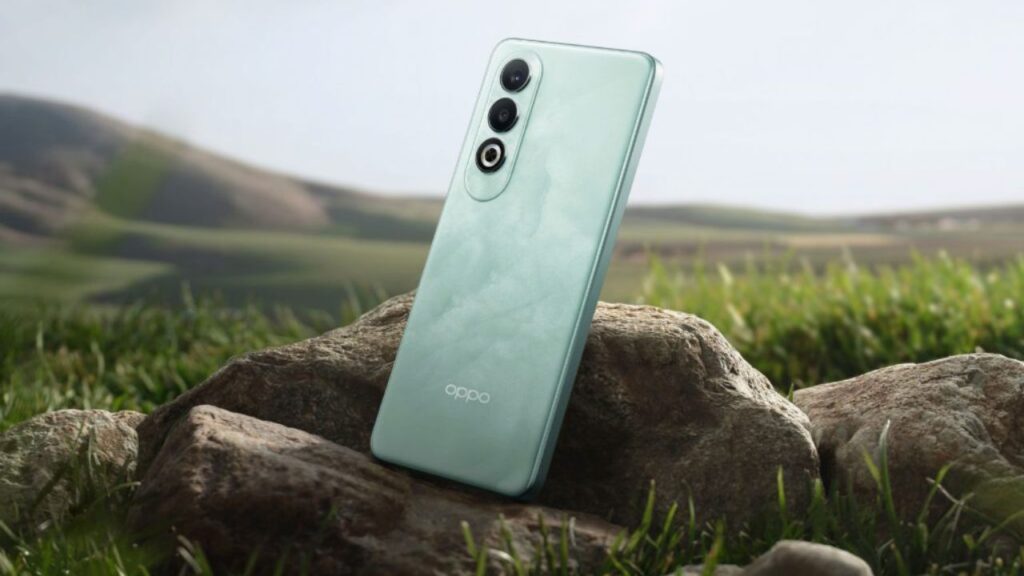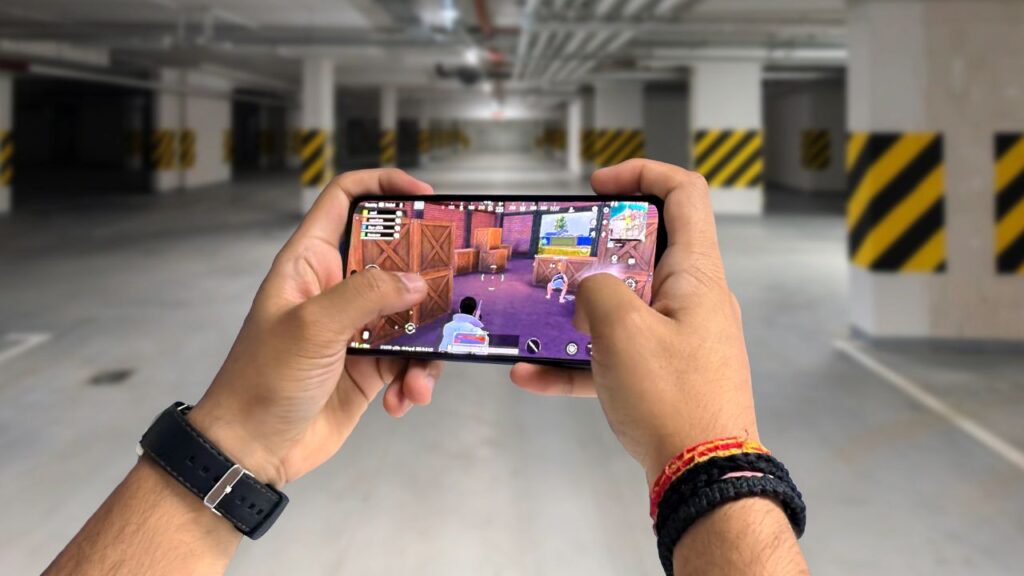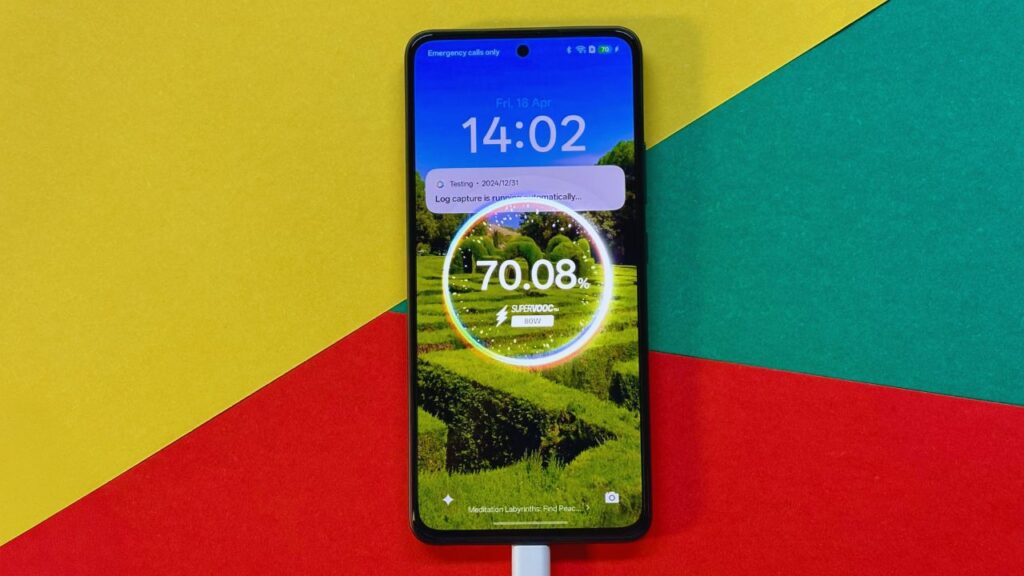OPPO K13: Priced from Rs 17,999, the OPPO K13 is positioned as an ‘OverPowered (OP) performance smartphone.’ It runs on the latest Qualcomm Snapdragon 6 Gen 4 SoC and packs a massive 7,000mAh battery, complemented by an 80W SuperVOOC fast charger. With the addition of a large Vapour Chamber cooling system, the K13 sets a new performance standard in the sub-20,000 category.
Build Quality and Visual Experience
The OPPO K13 makes a bold visual statement in its price range. We got our hands on the Icy Purple variant, which exudes a sleek, chilled-out charm. Its back panel features a dynamic, light-reflective pattern that shifts elegantly with every angle, lending a refined, premium touch.

The matte finish not only enhances the aesthetics but also resists fingerprints and smudges effectively. Topping off the design is a square-shaped camera module in the top right corner, housing dual cameras in a layout subtly reminiscent of the iPhone 16.
The OPPO K13 sports flat edges with gently rounded corners, ensuring a comfortable grip in the hand. While it’s not the slimmest or lightest device out there—measuring 8.45mm thick and weighing 208 grams—it makes a fair trade-off for its hefty 7,000mAh battery. The phone is also IP65-rated, offering solid protection against water and dust. In addition to the Icy Purple variant, it comes in a sleek Prism Black option that shares the same design qualities.
On the bottom edge, you’ll find a USB Type-C port, speaker grille, and SIM tray, while the right side houses the power button and volume rockers. The top edge includes an IR blaster for controlling home appliances and a secondary microphone. For audio, the K13 features stereo speakers, with the secondary speaker discreetly placed behind the earpiece. The output is crisp and balanced, delivering a solid experience at moderate volume levels.

When it comes to the viewing experience, the OPPO K13 delivers with a 6.67-inch AMOLED display that features a 120Hz refresh rate, FHD+ resolution, and up to 1,200 nits of peak brightness. It also supports HDR10+ content, though streaming platforms like Netflix and other OTT apps are currently limited to FHD playback. The display impresses with smooth, fluid animations—courtesy of the high refresh rate—and punchy, vibrant colours, thanks to its wide colour gamut. While outdoor visibility can dip slightly under harsh sunlight, overall performance remains strong. Although the bezels are somewhat noticeable, the display still offers a competitive viewing experience within its segment.
Camera Overview
The OPPO K13 features a dual rear camera setup, comprising a 50MP primary sensor and a 2MP depth sensor to enhance portrait photography. The cameras are arranged in a vertically stacked layout, reminiscent of the dual-lens design seen on the latest iPhone 16 series. On the front, the device houses a 16MP punch-hole selfie camera, ideal for self-portraits and video calls.

Under review of 91mobiles: The main sensor lacks optical image stabilisation (OIS), it includes electronic image stabilisation (EIS) to help minimise blur and maintain image clarity during handheld shots. The camera app offers a versatile range of shooting modes, including Night mode, High-Resolution, Panorama, Slow Motion, Time-lapse, Dual-View Video, and a built-in Document Scanner. For video recording, the rear camera supports up to 4K resolution at 30 frames per second.
When it comes to image quality, the OPPO K13 performs well in daylight conditions. The 50mp primary camera captures sharp, detailed photos with close-to-accurate colour reproduction, making it a dependable choice for everyday shots. The accompanying 2mp depth sensor enhances portrait mode with decent background separation and precise edge detection, delivering natural-looking bokeh effects. On the front, the 16mp selfie camera produces vibrant, well-detailed images that are ideal for social sharing. However, in low-light environments, the camera system struggles—photos tend to lose clarity and sharpness, revealing the limitations of the hardware in challenging lighting.
Performance and User Experience
The OPPO K13 is equipped with the Snapdragon 6 Gen 4 Soc, a chipset featured in several smartphones, including its direct rival, the Realme P3. This processor delivers smooth, lag-free performance, ensuring a seamless experience for both everyday tasks and power users who demand more from their device.

This was evident during our gaming tests, which included titles like BGMI, Call of Duty: Mobile, and Real Racing 3.
The phone performed admirably during gaming, with impressive thermal management. This can be attributed to its large 5,700mm² Vapour Chamber cooling system, which is touted as leading in its segment, as well as a 6,000mm² graphite sheet. After 90 minutes of continuous gaming, the phone’s temperature increased by just 8.1 degrees Celsius, lower than both the Realme P3 and Lava Blaze Duo.
Also See: Vivo T3 Ultra Review: Impressive Power at a Mid-Range Price
Battery Life and Charging Performance
The OPPO K13 is powered by a robust 7,000mAh graphite battery, claimed to outperform both silicone anode and Lithium-Ion batteries. This cutting-edge technology is designed for long-lasting performance, with a promised lifespan of up to five years, and the results back it up.

The device offers remarkable endurance, excelling in both synthetic benchmarks and real-world usage. In the PCMark battery test, which simulates typical smartphone activities until the battery drops to 20%, the OPPO K13 achieved an impressive runtime of around 17 hours, positioning it as one of the top performers in its segment.
Full Specifications
| Specification | Details |
|---|---|
| Price | Starting at Rs 17,999 |
| Chipset | Qualcomm Snapdragon 6 Gen 4 SoC |
| Display | 6.67-inch AMOLED, FHD+ resolution, 120Hz refresh rate, 1,200 nits peak brightness |
| HDR Support | HDR10+ |
| Rear Cameras | Dual setup: 50MP primary sensor + 2MP depth sensor |
| Front Camera | 16MP punch-hole selfie camera |
| Battery | 7,000mAh, Graphite battery (claimed superior to silicone anode and Lithium-Ion batteries) |
| Charging | 80W SuperVOOC, charges from 20% to 100% in 40 minutes |
| Build | Flat edges with rounded corners, matte finish, IP65 rating (water and dust-resistant) |
| Dimensions | 8.45mm thickness, 208 grams |
| Color Options | Icy Purple, Prism Black |
| Cooling System | Vapour Chamber cooling (5,700mm²) and graphite sheet (6,000mm²) |
| Audio | Stereo speakers (secondary speaker behind the earpiece) |
| Software | ColorOS (based on Android), various shooting modes (Night mode, Time-lapse, etc.) |
| Video Recording | 4K resolution at 30fps (rear camera) |
| Performance | Smooth performance with Snapdragon 6 Gen 4 SoC, excellent gaming performance |
| Thermal Management | 5,700mm² Vapour Chamber, temperature rise of 8.1°C after 90 minutes of gaming |
| Battery Life (PCMark Test) | 17 hours of runtime (simulated real-world usage) |
| Real-World Battery Usage | 1% battery drain after 30 minutes of YouTube streaming, 4% after 90 minutes of gaming |
Conclusion
The OPPO K13, priced from Rs 17,999, delivers excellent value in the sub-20,000 segment with its powerful Snapdragon 6 Gen 4 SoC, massive 7,000mAh battery, and 80W SuperVOOC charging. Its sleek design, 120Hz AMOLED display, and solid rear camera performance make it a standout choice for everyday use and gaming. The device excels in battery life, easily lasting two days, with fast charging that takes just 40 minutes to fully charge. Overall, the OPPO K13 offers impressive performance, durability, and value, making it a top contender in its price range.

